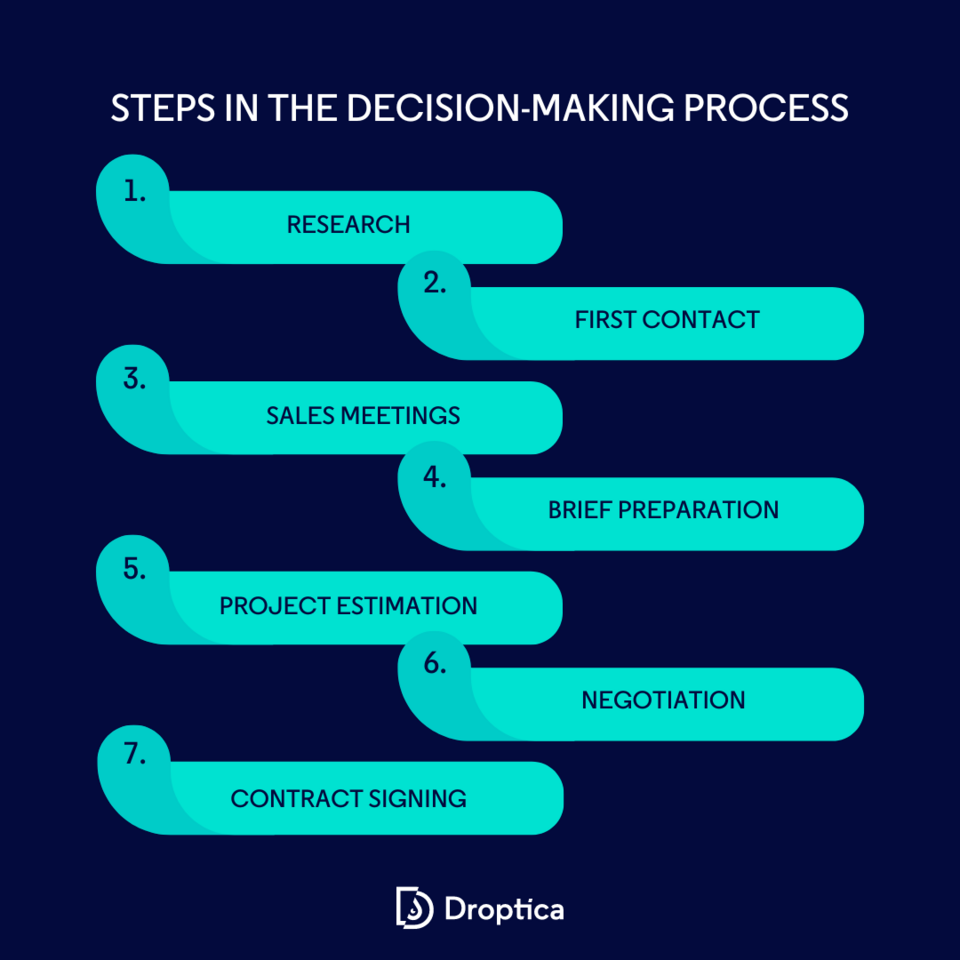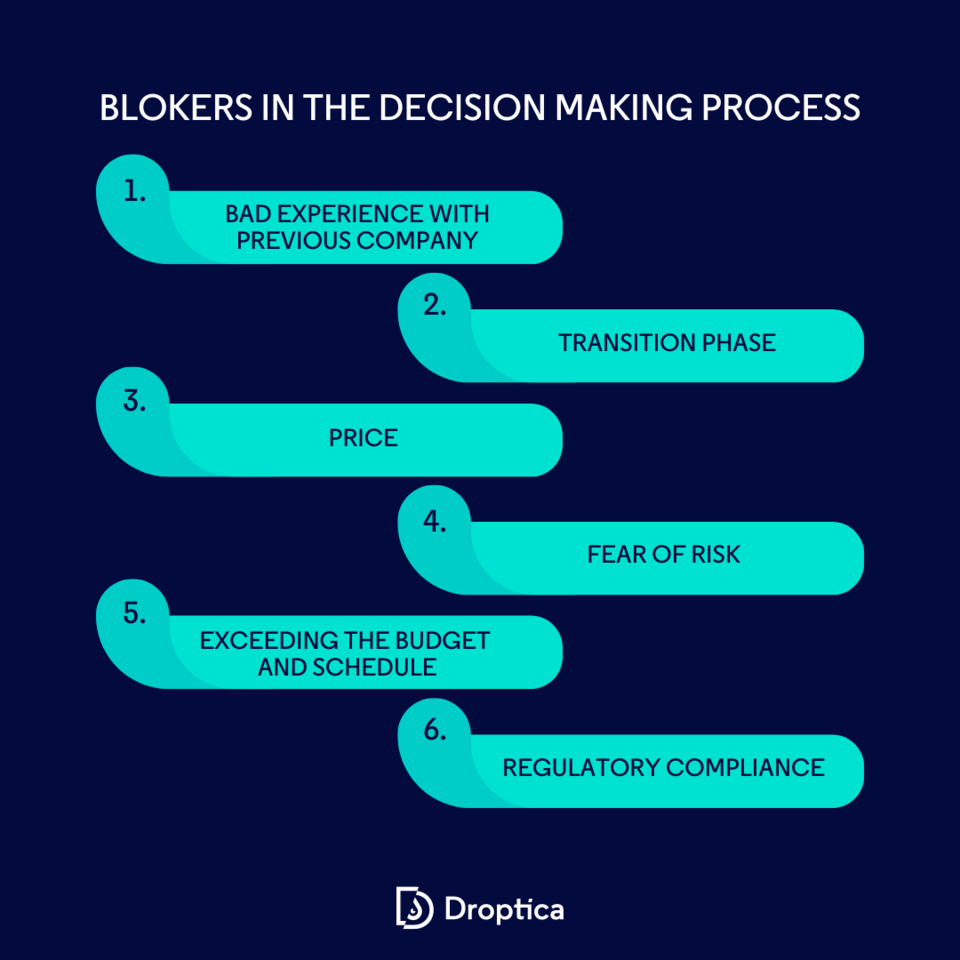
What are the Blockers in the Customer Decision Making Process?
In the complex world of software development, customers often find themselves at crossroads when deciding whether to work with a particular company. Understanding the nuances of the decision-making process is essential for service providers and their customers. In this blog post, we'll delve into the various obstacles to decision making and look at how Droptica, along with its sales team, is helping clients deal with these challenges.
What is the customer decision-making process?
Building a new project or establishing an application maintenance partnership aren’t simple or cheap purchases. They often involve a significant financial and time investment. Choosing a particular technology or contractor places some responsibility on the decision-makers in an organization. This could be the founder spending their money or representatives of the purchasing department in a large company who have a specific budget and are held accountable for it.
Therefore, there is the concept of a decision-making process. It’s a several-stage and complex activity based on due diligence, verification, common sense, and business-technical soundness. The decision-making process usually involves one or more people on the client's side and usually lasts at least several weeks before a decision is made to start working together. It’s essential to consciously analyze all the factors and reasons why it’s sometimes better to abandon a project than to be dissatisfied later with its failure.
What are the steps in the customer decision making process regarding software development?
The decisions in starting a project involve several key stages, such as research, first contact, sales meetings, brief preparation, project estimation, negotiation, and contract signing. The more prudence and awareness when going through these stages, the greater the chance of minimizing the risk of project failure.

While we don't require every client to have technical people on their team, a programmer or software architect will always allow better vetting of a potential service provider. Nevertheless, at Droptica, we try to speak the language of business without using complicated technical jargon. This is in line with our organizational culture. We want to deliver solid services without coloring the message with unnecessary information and focusing on reaching a specific goal as quickly as possible.
Our sales team is committed to ensuring that the client's expectations are addressed. It’s also important to us that the client is aware of both the potential successes and risks of the project at every stage of the decision-making process.
What blocks the customer in the decision-making process?
Each obstacle encountered causes downtime in the decision-making process. Sometimes, it results in postponing the resolution or ending the purchasing process altogether. Our role is to ensure transparency, provide relevant information, and empathize with the client's business or life dilemmas.
Everyone has goals, and the means to achieve them are often complex, intricate, and costly. For this reason, it isn’t worth treating customers as just another "sales lead," but try to look at each of them as a human being to whom you should give valuable assistance in exchange for adequate compensation.
Let's see what blockers often appear in the customer decision-making process in software development.

1. Bad experience with previous company
The IT market is full of freelancers and low-cost pricing companies, which at first glance seem an attractive choice. Indeed - the smaller the organization, the more agile the processes and the lower operating costs, resulting in lower rates. Unfortunately, it’s often the case that such service providers aren’t reliable and deviate in quality of work from the standards in the market.
Bad customer experiences most often include lack of transparency, delays in tasks and projects, no communication or ignoring of service recipient's comments, significant budget overruns, as well as errors, and harmful software building practices. The customer must ultimately answer for all this in the form of wasted money, time, or strained nerves.
At Droptica, we are prepared for all sorts of validation questions that come our way. "Challenging," i.e., verifying our assumptions, is perfectly understandable to us. During sales discussions, we are happy to encourage discussion.
We think it's always a good idea to ask a potential service provider about similar successfully completed projects, client references, how projects are run, transparency of information, and certificates or other evidence that shows the team's competence. We should also remember that we’re working with individuals on the project at the end of the day, so sometimes it’s also worth asking for a familiarization meeting with the target Project Manager or Tech Lead.
2. Transition phase
It’s often the case that if the client is dissatisfied with the current software agency, they look for alternatives. Then, it’s necessary to hand over the project to a new service provider, and a transition phase occurs. During it, whether we’re to complete the project or take over its maintenance, we must be given the necessary accesses to begin our work effectively.
The worst-case scenario is when the previous agency still owns the source code and repository and has access to the server (files and database). Remember to always insist on transferring ownership of the project, as the client pays for it.
Even if the client's team has little knowledge of the project handover requirements or encounters problems obtaining information from the current supplier, at Droptica, we always provide assistance. We advise and suggest how to properly proceed in such a situation.
3. Price
It’s natural for any business decision to have a rationale behind it. One of the most important factors is the price, which is directly correlated with the investment in a given venture. It’s no trick to overpay for something, although it’s also possible to exaggerate in the other direction, disregarding the quality of service. The best indicator is the ratio of price to quality and the number of solutions proposed, which will directly affect the monetization and return on the project and the billing transparency.
At Droptica, we try to match the client and their expectations depending on what stage of the decision-making process they’re currently at. If a customer needs to know the broad scale of the project, especially at the beginning of discussions with us, we can pre-estimate cost spreads and lead times.
When the initial budget is acceptable, we’re eager to engage both parties in more detailed and substantive discussions, during which we articulate the needs and solutions, and, at the end, prepare an exact estimate broken down by epic, task, and user stories. Each item has a described level of certainty and an hourly "from - to" fork. The higher the certainty scale, the smaller the fork ranges. The total hours are finally tallied up, we propose a suitable team for this and calculate the budget and completion time.
Of course, our project estimation is subject to negotiation and prioritization, so if the client wants to go through the entire document with us and posit requirements, we’re happy to do so during our meetings.
4. Fear of risk
The consequences of making wrong decisions often lower the morale of individuals in an organization. Unfortunately, the risk of project failure always has been and always will be. The only thing we can do together is to minimize the risks. Potential problems can arise from soft skills (e.g., communication, organization, management skills, experience) and hard skills (e.g., new or niche technology, technological limitations). If the customer's concerns aren’t adequately addressed, procrastination and postponement of decisions often occur, ending in silence until eventually contact is lost altogether.
In order to minimize risks and fears of failure, first of all, we proactively come out in front of such situations. Suppose the client isn’t convinced of a particular technology. In that case, we suggest starting the cooperation from the phase of technical discovery workshops or the Proof of Concept method, i.e., implementing a short-term project to demonstrate the validity of a given solution. This type of service allows, at a relatively low cost and time, to verify the assumptions more reliably than mere estimation and verbal assurances.
In addition, at Droptica, we make sure that neither party hardens its ideas. The fact that we specialize in Drupal doesn’t mean we have to implement every project in it. Similarly, when a client becomes convinced of a particular technology, we also don’t start work without a thorough analysis of its effectiveness and feasibility. If we honestly don't see a clear justification for using a particular technology or making the investment at all, we’ll advise against it and suggest an other solution or even another service provider.
5. Exceeding the budget and schedule
This issue is directly related to the previous point about risk. In practice, no formality will ensure that the project will be completed within the allotted time and budget. Paper can accept anything, while reality looks different. Of the available contract forms in the software delivery industry, the most common are Fixed Price or Time&Materials contracts.
In the case of the former, the client agrees to pay a flat, fixed amount to complete the project. Despite the apparent security, often with this type of contract, external factors (e.g., a change in the market and requirements by a pandemic or sudden changes in laws) cause the project to fall into what is known as scope creep. This refers to endless changes that are impossible to complete within a specific budget. This often causes a drop in morale on both sides, unnecessary conflicts, and ultimately – the project and its ideas lose the most.
The Time&Materials contract, on the other hand, is flexible, as we only bill for time worked and code delivered. Here, there is a theoretical risk that the project will drag on, and the client will be obliged to pay the service provider for the time worked.
In both cases, it’s essential to start projects with clearly defined requirements and conduct them in an organized, transparent manner and with constant communication. At Droptica, we provide a dedicated Project Manager and Tech Lead who work closely with the client and monitor the project's progress. Their task is to systematically report on the progress and predictions of the successful implementation of the project.
The client has an overview of the project details in our project management system – JIRA. As soon as we notice any worrying signals, we immediately inform the client, and together we take an action plan. We adjust the team and requirements and redefine priorities to ensure the project achieves its intended goal within the agreed time and budget.
6. Regulatory compliance
The last aspect that large companies, corporations, or government institutions pay special attention to is compliance with required regulations, such as security. Even the best-looking company cannot become a subcontractor if it doesn’t meet critical regulatory requirements.
It’s worth verifying that the company isn’t in liquidation or bankruptcy before signing contracts. In addition, you should ask the potential service provider to show the relevant compliance certifications and check that employees are equipped with hardware and software to secure user data in the project.
At Droptica, we ensure our clients are fully secure, so we’re an ISO/IEC 27001 certified company – an international standard that normalizes information security management systems. In addition, all our employees are directly employed by our company and have properly secured hardware and software.
We also take care of the paperwork. Our contracts consist of three documents: a framework agreement defining the principles of cooperation, a procurement agreement defining the scope and budget of a given project, and a personal data processing agreement to properly regulate compliance with RODO and information security.
Customer decision-making process – summary
Joint understanding and overcoming obstacles in the software development decision making process is the key to project success. Success is a product of the efforts of both parties. In this 10th anniversary year of Droptica's existence in the software development industry, Droptica's commitment to our client's satisfaction remains unwavering while creating a framework for further collaboration and innovation. If you want to consciously start working together and make a real difference in the world through digital projects, contact our team and learn more about an experienced Drupal agency.











